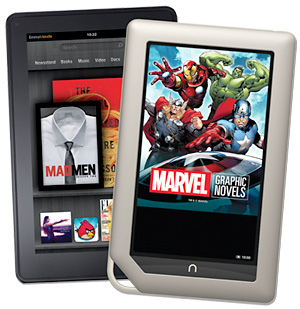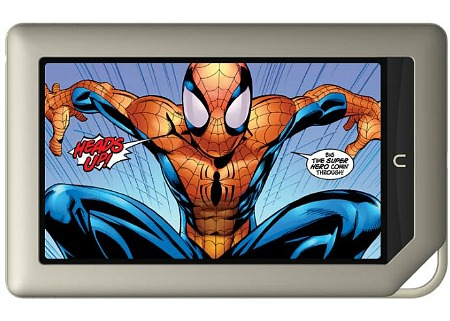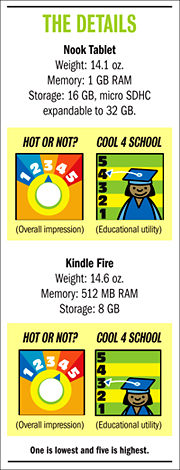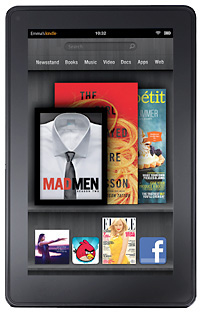
It’s been a frequently asked—and highly contentious—question since their nearly simultaneous release in mid-November: Which is the better color ereader/tablet, the Kindle Fire or the Nook Tablet? I had the opportunity to test the popular devices side by side, so, like it or not, here’s my verdict:
Nook Tablet

Nook tablet
First of all, these little tablets—neither of them exactly iPad killers—are much more similar than they are different. While not full-blown tablets like the iPad or the dozens of like-sized Android competitors, they’re both great at what they’re intended to do. Both are WiFi only, sport similar seven-inch, 1024 x 600 capacitive multi-touch screens that are crisp and vibrant, and boast battery life of about eight hours per charge.
Both are powered by similar 1GHZ dual-core processors and run versions of the Android 2.3 (Gingerbread) OS with customized user interfaces that access their respective stores featuring limited selections of approved apps rather than offering everything you’d find in the overall Android marketplace. While the Kindle Fire is clearly geared towards channeling users to Amazon’s wide-ranging ebook and movie/TV show content and Amazon’s associated cloud storage, the Nook tablet relies a bit more on third-party content, especially for streaming media.
 Perhaps because of that, the Nook Tablet features twice as much internal storage (16GB vs. 8GB) as the Kindle Fire and it has an SDHC card slot for an additional 32GB of removable storage. With 1GB of RAM to the Kindle Fire’s 512MB, one might expect nimbler performance from the Nook Tablet, but I really didn’t notice much of a difference. Plus, while the Nook Tablet has beefier hardware, Amazon offers the Kindle Fire at $199—50 bucks less than the Nook Tablet. Presumably because Amazon is betting Fire users will more than make up for that initial loss in device sales profit as they subsequently pick and choose from Amazon’s superior catalog of proprietary content.
Perhaps because of that, the Nook Tablet features twice as much internal storage (16GB vs. 8GB) as the Kindle Fire and it has an SDHC card slot for an additional 32GB of removable storage. With 1GB of RAM to the Kindle Fire’s 512MB, one might expect nimbler performance from the Nook Tablet, but I really didn’t notice much of a difference. Plus, while the Nook Tablet has beefier hardware, Amazon offers the Kindle Fire at $199—50 bucks less than the Nook Tablet. Presumably because Amazon is betting Fire users will more than make up for that initial loss in device sales profit as they subsequently pick and choose from Amazon’s superior catalog of proprietary content.
Kindle Fire
Which brings me to a big point: being a librarian, I think it’s in my DNA to bristle at any device that tries to lock me into its proprietary content—especially when it comes to ebooks. Freedom of choice is a huge deal to me. And, frankly, neither tablet comes close to actually inviting you to buy ebooks from competing vendors. You won’t, for example, find a Nook app in the Kindle store, nor a Kindle app in the Nook store, which I think is a big disadvantage compared to using a tablet running a vanilla version of Android as an ereader.
In pursuit of said freedom, I did find a hit-and-miss workaround: if you go to the settings menu in either device, you can elect to allow installs from “unknown” developers and then use your web browser to download and install apps not available in either device’s app stores. To make this even easier, I first used each tablet’s browser to install a noncommercial app store application called GetJar. I then used that app to select and install other ebook apps like Kobo and Aldiko onto my Nook Tablet and the Nook and Kobo onto my Kindle Fire. Free at last!
It’s worth mentioning, though, that the newest Kindle app wouldn’t install on my Nook Tablet. Moreover, I couldn’t get non-Nook approved apps to display on the Nook Tablet’s main app menu, so I had to launch them from the search prompt. The Kindle Fire, on the other hand, automatically displayed the nonnative Kobo and Nook apps in its slick carousel menu.
 So, which is the better color ereader/tablet? That’s a tough call. I think it totally depends on the user’s needs. If, for instance, you’re a school librarian who wants to load up a device with primarily ebook content that’s available to borrowers offline, the Nook Tablet would clearly be worth the extra $50. Techies who want to root their device to make it a relatively inexpensive vanilla Android tablet would also be happier with the Nook.
So, which is the better color ereader/tablet? That’s a tough call. I think it totally depends on the user’s needs. If, for instance, you’re a school librarian who wants to load up a device with primarily ebook content that’s available to borrowers offline, the Nook Tablet would clearly be worth the extra $50. Techies who want to root their device to make it a relatively inexpensive vanilla Android tablet would also be happier with the Nook.
On the other hand, if users will typically be WiFi connected and are most interested in convenient, cloud-based access to a wide-ranging catalog of pay-per-view streaming media, then the Kindle Fire wins, hands down.
You choose.



One user say that the kindle fire is $50 less than the nook tablet but they are both $199. Go to Barns & Nobles and get all the info about the nook tablet. They are really good on getting you all the infoyou need to know.
Lexi is right on! Barnes and Noble, sometime after this review was filed, released an additional 8GB model Nook Tablet for $199 which more closely lines up with the Kindle Fire in terms of hardware and price. The 16GB model contnues to sell at the original price.
I read this article because I thought an “educator” would be more inclined to look at the devices ability to “read books.” Who cares that the fire offers “cloud-based access to a wide-ranging catalog of pay-per-view streaming media” I mean how many schools are actually looking for pay per view movies? And while there are some learning apps, how many schools are concerned about loading third party apps?
You totally missed that the Nook Tablet reads epub books from nearly any source. One can go to Barnes and Noble, Sony, Google, project Gutenberg, etc and download thousands of books for the Nook. Many publishers also offer epub book sales direct to the customer. The Kindle fire requires that you mess around with the software and load unsupported apps to get these books.
In my experiences when it comes to schools there is not even a comparison between the two. If you want freedom to get books from multiple sources, and you actually want your students to read go with the Nook.
Hi Jeff,
I have read else where that even though Nook has about 8 or 16GB of memory it just offers only 1GB for user and B&N is going to re work on this. So, did they really offer any work around for allocating more than 1G for user or is it still the same?